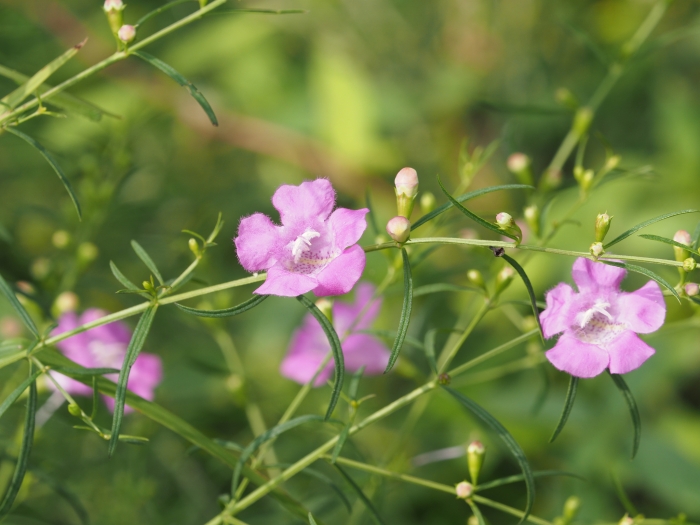Purple False Foxglove
(Agalinis purpurea)
Purple False Foxglove (Agalinis purpurea)
/
/

mefisher
Public Domain
Image By:
mefisher
Recorded By:
Copyright:
Public Domain
Copyright Notice:
Photo by: mefisher | License Type: Public Domain | License URL: http://creativecommons.org/publicdomain/zero/1.0/ | Rights Holder: mefisher | Publisher: iNaturalist | Date Created: 2020-09-14T11:53:06-07:00 |


















































Estimated Native Range
Summary
Agalinis purpurea, commonly known as Purple False Foxglove, is an annual herb native to a variety of habitats including open woodlands, grasslands, savannas, and along stream banks in the Eastern and Central United States. It typically grows to a height of 10 to 120 centimeters and has a slender stem with spreading branches. The leaves are simple, opposite, and linear, measuring 10 to 40 millimeters in length and 0.5 to 2 millimeters in width. From late summer to fall, it produces showy tubular flowers that are pink to purple with a white throat, attracting pollinators such as bees and hummingbirds.
Purple False Foxglove is appreciated for its delicate flowers and ability to attract wildlife. It is used in wildflower gardens, meadow plantings, and restoration projects. This plant thrives in full sun but can tolerate light shade. It prefers moist to wet soils with good drainage and can be found naturally in areas that are seasonally wet. While it is not a high-maintenance plant, it can be susceptible to root rot in overly saturated soils. It is also a hemiparasite, meaning it can derive nutrients from the roots of neighboring plants, which should be considered when planting.CC BY-SA 4.0
Purple False Foxglove is appreciated for its delicate flowers and ability to attract wildlife. It is used in wildflower gardens, meadow plantings, and restoration projects. This plant thrives in full sun but can tolerate light shade. It prefers moist to wet soils with good drainage and can be found naturally in areas that are seasonally wet. While it is not a high-maintenance plant, it can be susceptible to root rot in overly saturated soils. It is also a hemiparasite, meaning it can derive nutrients from the roots of neighboring plants, which should be considered when planting.CC BY-SA 4.0
Plant Description
- Plant Type: Herb
- Height: 1-2.5 feet
- Width: 0.5-1.5 feet
- Growth Rate: Moderate
- Flower Color: Pink, Purple
- Flowering Season: Summer, Fall
- Leaf Retention:
Growth Requirements
- Sun: Full Sun
- Water: Medium, High
- Drainage: Medium, Fast
Common Uses
Bee Garden, Bird Garden, Border Plant, Butterfly Garden, Hummingbird Garden, Low Maintenance, Showy Flowers, Water Garden
Natural Habitat
Native to open woodlands, grasslands, savannas, and along stream banks
Other Names
Common Names: Purple Gerardia, Purple Agalinis, Gérardie Pourpre
Scientific Names: , Agalinis purpurea, Gerardia purpurea, Agalinis purpurea var. carteri, Gerardia keyensis, Agalinis keyensis, Gerardia purpurea subsp. parvula, Aureolaria purpurea var. intermedia, Gerardia purpurea f. albiflora, Gerardia purpurea var. crassifolia
GBIF Accepted Name: Agalinis purpurea (L.) Pennell